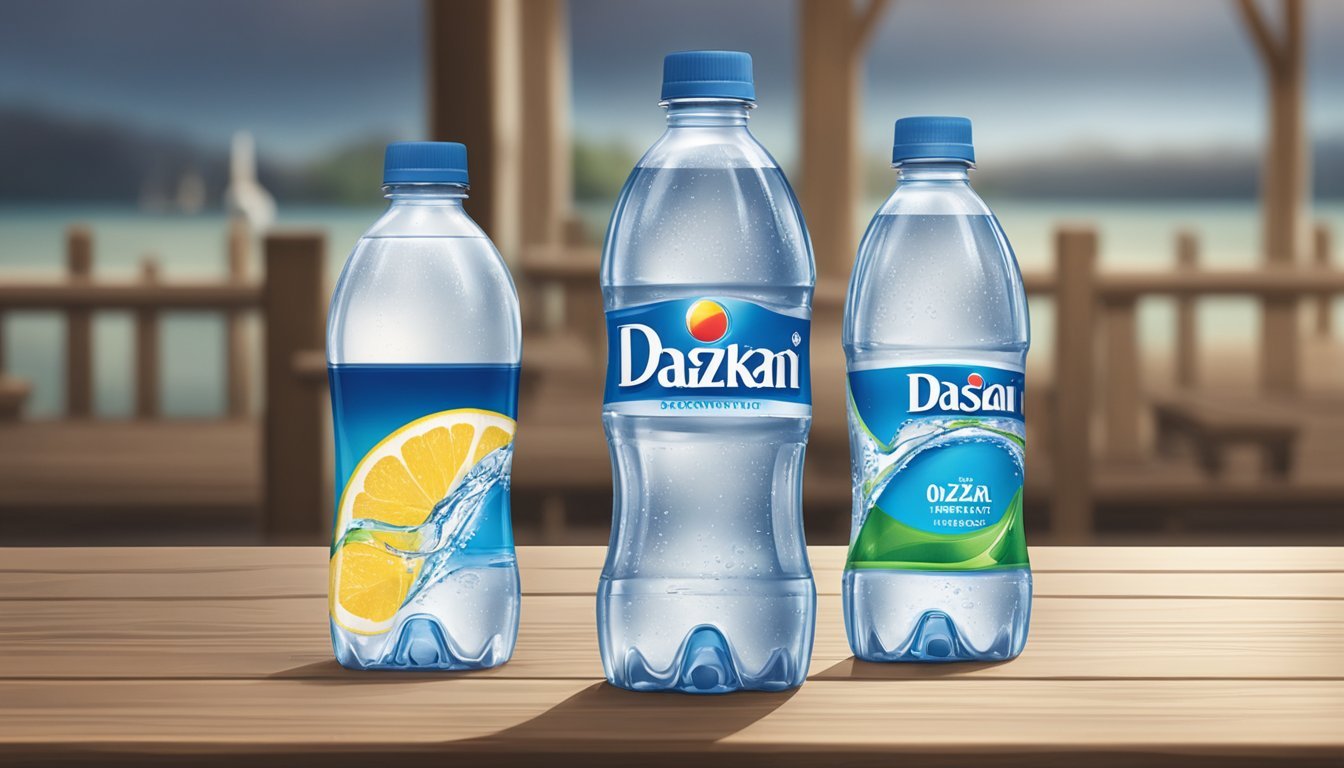Ozarka vs. Dasani
Comparing Quality and Taste
When it comes to choosing between Ozarka and Dasani bottled water, consumers often weigh factors like taste and purity. Ozarka, known for its natural spring water sourced from specific springs in Texas, boasts a clean and refreshing taste that many find appealing. Dasani, on the other hand, uses purified water from local sources and enhances it with minerals for a distinct flavor.
Spring water enthusiasts often prefer Ozarka for its natural origin, claiming it offers a more authentic and satisfying hydration experience. Dasani’s filtration process, including reverse osmosis, provides a consistent and reliable bottled water option, making it a favorite for those who prioritize purity and added minerals.
While both brands have their unique advantages and loyal followers, the best choice ultimately depends on whether one values the natural allure of spring water or the meticulously purified taste of enhanced water. Each brand has carved out its niche in the ever-competitive bottled water market, ensuring there's a suitable option for every preference.
Understanding Bottled Water
Bottled water comes in various types, each with distinct characteristics. Tap water, in contrast, is regulated differently. It's important to understand the specific regulations that govern the production and distribution of bottled water.
Types of Bottled Water
Bottled water is categorized into several types based on its source and treatment. Spring water originates from underground formations and must flow naturally to the surface. Mineral water contains minerals and trace elements occurring at constant levels.
Purified water, like Dasani, goes through extensive purification processes such as reverse osmosis. Artesian water is sourced from confined aquifers, while alkaline water has a higher pH level, which some believe offers health benefits. These variations cater to different consumer preferences and needs.
Bottled Water vs. Tap Water
While bottled and tap water both provide hydration, their sources and treatment methods differ. Tap water is typically sourced from surface or groundwater and treated to meet EPA standards. This includes disinfection and filtration to remove contaminants.
Bottled water, governed by FDA regulations, must meet specific standards for safety and quality. Unlike tap water, it often undergoes additional processing, such as distillation or deionization. Consumers may prefer bottled water for its convenience and variety, though tap water is generally more cost-effective.
Bottled Water Regulations
The bottling and distribution of water are subject to stringent regulations. The FDA oversees bottled water, ensuring it meets safety and labeling standards. Bottled water must be free from harmful contaminants and correctly labeled regarding its source and treatment.
EPA regulations apply to tap water, setting maximum contaminant levels for various substances. Bottled water standards are comparable to those for tap water but are regulated as a packaged food product. Compliance with these regulations assures consumers of the water’s safety and quality.
Profile of Ozarka and Dasani
Ozarka and Dasani are popular bottled water brands with distinct sources and filtration processes. Their marketing strategies also differ, contributing to their unique brand images.
Ozarka's Source and Filtration Process
Ozarka sources its water from natural springs in Texas, emphasizing its commitment to delivering pure spring water.
The brand employs multi-step filtration to ensure quality. This includes removing impurities while preserving naturally occurring minerals.
Ozarka claims its natural spring source and careful purification enhance the water's taste and quality, appealing to consumers who prefer natural spring water.
Dasani's Source and Hydro-7 Filtration
Dasani, owned by Coca-Cola, sources its water from local municipal supplies. The water undergoes a rigorous purification process called Hydro-7.
This includes reverse osmosis, removing impurities and adding minerals for taste.
Dasani's Hydro-7 process aims to deliver consistent, clean, and refreshing water, making it a strong contender in the purified water market.
Marketing and Brand Image
Ozarka markets itself as a natural, pure spring water brand. Its messaging emphasizes the natural origins and purity, attracting consumers seeking authentic spring water.
Dasani's marketing, backed by Coca-Cola, promotes its scientifically purified water. The focus is on the advanced Hydro-7 filtration process and the brand's consistency.
Both brands leverage their unique strengths to appeal to different consumer preferences.
Health and Hydration
Both Ozarka and Dasani bottled waters offer unique benefits in terms of hydration, mineral content, and purity. It's important to understand the specifics and differences between these brands to make an informed choice.
Electrolytes and Mineral Content
Dasani enhances its water with a blend of minerals. This includes magnesium sulfate, potassium chloride, and salt. These additions aim to improve taste and provide some health benefits, though the quantities may be minimal compared to naturally mineral-rich waters.
Ozarka sources its water from natural springs in Texas, which naturally contain minerals such as calcium, magnesium, and sodium. These minerals can contribute to overall hydration and health by helping maintain electrolyte balance.
pH Levels and Acidity
The pH level of bottled water can influence its taste and how it interacts with the body's pH balance. Dasani typically features a slightly acidic pH level, around 5.6 to 6.0. This is achieved through its purification process and the addition of minerals.
Ozarka spring water usually has a more neutral pH level, from 6.5 to 7.8. The natural origins of the water allow it to maintain this range, which may be preferable for those seeking water that is less acidic and close to neutral.
Contaminants and Purity
Purity is a crucial factor when evaluating bottled water. Dasani uses a rigorous filtration process, including reverse osmosis, to remove contaminants. The water is then purified and enhanced with minerals to ensure it is free from harmful substances.
Ozarka prides itself on the purity of its naturally sourced spring water. The water undergoes multiple quality checks to ensure it meets safety standards. However, being a natural product, it may contain trace amounts of naturally occurring minerals, unlike the purified nature of Dasani which focuses on eliminating such elements.
Taste Profiles
Taste profiles of bottled water can vary significantly based on several factors such as the source and treatment process. It's important to consider how these elements influence the flavor.
Water Flavor Factors
Several factors determine the taste of bottled water. Source is a primary contributor; spring water will have different taste notes compared to purified water. Minerals added during processing can enhance (or detract from) the taste. Filtration methods also play a role; for example, reverse osmosis can lead to a cleaner and more neutral taste.
Another factor is packaging, which may impact the water's overall flavor. Plastics can sometimes impart a slight taste, noticeable by sensitive palates. Storage conditions, like exposure to light and heat, can also alter taste over time.
Brand-Specific Taste Characteristics
Ozarka uses natural spring water, giving it a taste that many describe as crisp and refreshing. The distinctive mineral content contributes to its natural flavor, making it feel like drinking from a mountain spring. It’s particularly renowned for its clean finish and lack of aftertaste, making it a favorite for many.
Dasani, on the other hand, utilizes purified water through reverse osmosis. This process removes impurities but also strips the water of natural minerals, which are then reintroduced. The result is a taste often described as fresh and clean, but some critics note a slight tang due to the added minerals. Some also detect a subtle aftertaste from the filtration process.
Environmental and Ethical Considerations
Both Ozarka and Dasani face scrutiny regarding their environmental impact, especially concerning plastic bottle usage and recycling practices.
Plastic Bottles and Recycling
Ozarka utilizes plastic bottles primarily made from PET, which is recyclable. The brand claims to promote recycling and reduce waste by encouraging consumers to dispose of bottles properly. However, a significant challenge remains in ensuring these bottles are actually recycled.
Dasani also uses PET plastic for its bottles and actively promotes recycling. The brand has introduced efforts to use more recycled plastic in their packaging, aiming to reduce the environmental footprint. Despite these efforts, the issue of plastic waste continues to be a major concern.
Both brands need to enhance their recycling initiatives and reduce plastic dependence to improve their environmental impact.
More About Ozarka
Mountain Valley Spring Water vs Ozarka: Which Bottled Water is Better?
Ozarka vs Kirkland Signature: Which Bottled Water is Better?
Ozarka vs Richard's Rainwater: Which Bottled Water is Better?
Ozarka vs Whole Foods Italian Still Mineral water: Which Bottled Water is Better?




